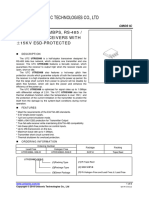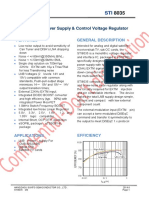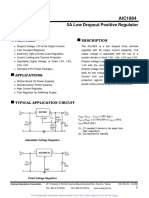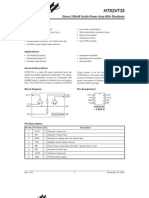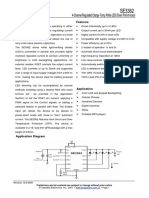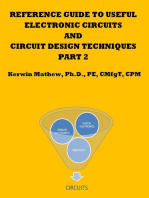A6110 说明书
A6110 说明书
Uploaded by
吴杰东Copyright:
Available Formats
A6110 说明书
A6110 说明书
Uploaded by
吴杰东Copyright
Available Formats
Share this document
Did you find this document useful?
Is this content inappropriate?
Copyright:
Available Formats
A6110 说明书
A6110 说明书
Uploaded by
吴杰东Copyright:
Available Formats
AiT Semiconductor Inc.
A6110
www.ait-ic.com LOW DROPOUT VOLTAGE REGULATOR
1A HIGH PSRR CMOS,LINEAR REGULATOR
DESCRIPTION FEATURES
The A6110 is a low-dropout regulator that operates Up to 1A Output Current
the input voltage from 2.5V to 6V and delivers 1 A 70uA Operating Supply Current
load current. The A6110 is available in fixed output Excellent Line Regulation: 0.05%/V
voltage. The output voltage of the fixed types is
Low Dropout: 350mV@1A(VOUT=3.3V)
preset at an internally trimmed voltage 1V, 1.2V,
High Power Supply Rejection Ratio
1.3V, 1.5V, 1.8V, 2.5V, 2.7V, 2.8V, 2.85V, 3.0V,
Wide Operating Voltage Range: 2.5V to 6.0V
3.2V, 3.3V, 5V or can be made with options of the
output range from 1V to 5V in 50mV increments. 1V to 5V Factory-Preset Output
High Accuracy:±2%
The A6110 consists of a voltage reference unit, an Built-in Auto Discharge Function
error amplifier, resistor net for setting output voltage, 500mA in-rush Current Limit
a current limit circuit for over-current and a Fold-back Current Limit Protection
thermal-shutdown circuit.
Thermal Shutdown Protection
Available in TO252-3 and SOT223-3 packages.
The A6110 is available in TO252-3 and SOT223-3
packages.
APPLICATION
ORERING INFORMATION Portable Communication Equipment
Package Type Part Number Battery-Powered Equipment
TO252-3 A6110DR-XXZ Laptop, Palmtops, Notebook Computers
D
SPQ: 2,500pcs/Reel A6110DVR-XXZ
Hand-Held Instruments
SOT223-3 A6110NR-XXZ
N
SPQ: 2,500pcs/Reel A6110NVR-XXZ PCMCIA Cards and Wireless LAN
XX: Output Voltage
Cameras & VCRs
25=2.5V, 33=3.3V
Z: Package Type
Note
see pin description
V: Halogen free Package TYPICAL APPLICATION
R: Tape & Reel
AiT provides all RoHS products
REV1.7 - OCT 2010 RELEASED, APR 2016 UPDATAED - -1-
AiT Semiconductor Inc. A6110
www.ait-ic.com LOW DROPOUT VOLTAGE REGULATOR
1A HIGH PSRR CMOS,LINEAR REGULATOR
PIN DESCRIPTION
Top View Top View
Pin Number
TO252 Symbol Functions
A B
1 2 GND Ground Pin
2 3 VOUT Output Pin
3 1 VDD Input Pin
Top View Top View Top View Top View
Pin Number
SOT223-3 Symbol Functions
A B C D
1 2 3 3 VOUT Output Pin
2 1 1 2 GND Ground Pin
3 3 2 1 VDD Input Pin
REV1.7 - OCT 2010 RELEASED, APR 2016 UPDATAED - -2-
AiT Semiconductor Inc. A6110
www.ait-ic.com LOW DROPOUT VOLTAGE REGULATOR
1A HIGH PSRR CMOS,LINEAR REGULATOR
ABSOLUTE MAXIMUM RATINGS
VDD, Input Supply Voltage -0.3V ~ +7V
Output Voltage -0.3V~VIN+0.3V
Output Current 1.4A
Maximum Junction Temperature 125°C
Operating Temperature Range NOTE1 -40°C~85°C
Storage Temperature Range -65°C~125°C
Lead Temperature (Soldering, 10s) 300°C
Stresses above may cause permanent damage to the device. These are stress ratings only and functional operation of the device at
these or any other conditions beyond those indicated in the Electrical Characteristics are not implied. Exposure to absolute maximum
rating conditions for extended periods may affect device reliability.
NOTE1: The A6110 is guaranteed to meet performance specifications from 0°C to 70°C. Specifications over the -40°C to 85°C operating
temperature range are assured by design, characterization and correlation with statistical process controls.
THERMAL RESISTANCE NOTE2
Package θJA θJC
TO252-3 90°C/W 10°C/W
SOT223-3 160°C/W 20°C/W
NOTE2: Thermal Resistance is specified with approximately 1 square of 1 oz copper.
REV1.7 - OCT 2010 RELEASED, APR 2016 UPDATAED - -3-
AiT Semiconductor Inc. A6110
www.ait-ic.com LOW DROPOUT VOLTAGE REGULATOR
1A HIGH PSRR CMOS,LINEAR REGULATOR
ELECTRICAL CHARACTERISTICS NOTE3
VDD= VOUT +1V, and if VOUT < 1.5V, VDD=2.5V, CIN=2.2μF, COUT=2.2μF, TA=25°C, unless otherwise specified.
Parameter Symbol Conditions Min TYP Max Units
Input Voltage VDD 2.5 - 6 V
Output Voltage Accuracy ∆VOUT IOUT = 1mA -2 - +2 %
Current Limit ILIM 1.0 1.3 - A
Short Circuit Current ISCC VOUT = 0 - 250 - mA
Quiescent Current IQ IOUT = 0mA - 70 120 μA
1.2V - 420 -
1.5V - 260 -
1.8V - 180 -
IOUT = 300mA
2.5V - 140 -
3.3V - 110 -
5.0V - 100 -
Dropout Voltage NOTE4 VDROP mV
1.2V - 870 -
1.5V - 700 -
1.8V - 570 -
IOUT = 1A
2.5V - 440 -
3.3V - 350 -
5.0V - 340 -
1.2V
2.5V ≤ VDD ≤ 6V,
1.5V
IOUT = 100mA
1.8V
3.0V ≤ VDD ≤ 6V,
2.5V
Line Regulation NOTE5 ∆VLINE IOUT = 100mA - 0.05 0.5 %/V
3.8V ≤ VDD ≤ 6V,
3.3V
IOUT = 100mA
5.5V ≤ VDD ≤ 6V,
5.0V
IOUT = 100mA
REV1.7 - OCT 2010 RELEASED, APR 2016 UPDATAED - -4-
AiT Semiconductor Inc. A6110
www.ait-ic.com LOW DROPOUT VOLTAGE REGULATOR
1A HIGH PSRR CMOS,LINEAR REGULATOR
Parameter Symbol Conditions Min TYP Max Units
Load Regulation NOTE6 ∆VLOAD 1mA ≤ IOUT ≤ 1A - 20 - mV
Output Voltage NOTE7 IOUT = 100mA,
TCVOUT - ±100 - ppm/°C
Temperature Coefficient -40°C ≤ T ≤ 85°C
Output Noise Voltage eNO 10Hz to100kHz, IOUT = 1mA - 45 - uVRMS
Power f = 1kHz
- 70 -
Supply (VOUT ≤ 3.3V)
PSRR 0.2VP-P Ripple, IOUT = 100mA dB
Rejection f = 1kHz
- 60 -
Ratio (VOUT > 3.3V)
Thermal Shutdown
TSD Shutdown, Temp increasing - 165 - °C
Temperature
Thermal Shutdown
TSDHY - 30 - °C
Hysteresis
Output Discharge
RDSC - 50 - Ω
Resistance
NOTE3: 100% production test at +25°C. Specifications over the temperature range are guaranteed by design and characterization.
NOTE4: The required minimum input operating voltage is equal to VOUT + VDROP, and if VOUT + VDROP < 2.5V, the required minimum input
operating voltage must be set to 2.5V. VOUT is the normal output voltage, e.g. VOUT = 2.8V for 2.8V fixed output version.
NOTE5: Line regulation is calculated by ∆VLINE = [(VOUT1 - VOUT2)/ (∆VDD x VOUT)] x 100
Where VOUT1 is the output voltage when VDD1 = 6.0V, and VOUT2 is the output voltage when VDD2 = max (VOUT + 0.5V, 2.5V).
∆VDD = VDD1 - VDD2.
NOTE6: Load regulation is calculated by ∆VLOAD = VOUT1 - VOUT2
Where VOUT1 is the output voltage when IOUT1=1mA, and VOUT2 is the output voltage when IOUT2 = 1.0A.
NOTE7: The temperature coefficient is calculated by TCVOUT = ∆VOUT/ (∆T x VOUT)
REV1.7 - OCT 2010 RELEASED, APR 2016 UPDATAED - -5-
AiT Semiconductor Inc. A6110
www.ait-ic.com LOW DROPOUT VOLTAGE REGULATOR
1A HIGH PSRR CMOS,LINEAR REGULATOR
TYPICAL PERFORMANCE CHARACTERISTIC
VDD = VOUT + 1V, and if VOUT < 1.5V, VDD = 2.5V, CIN = 2.2μF, COUT = 2.2μF, TA = 25°C, unless otherwise noted.
1. Output Voltage vs. Input Voltage (1.0V) 2. Dropout Voltage vs. Output Current (3.3V)
3. Output Voltage vs. Input Voltage (3.3V) 4. Output Voltage vs. Temperature (3.3V)
5. Quiescent Current vs. Temperature (3.3V) 6. Quiescent Current vs. Input Voltage (3.3V)
REV1.7 - OCT 2010 RELEASED, APR 2016 UPDATAED - -6-
AiT Semiconductor Inc. A6110
www.ait-ic.com LOW DROPOUT VOLTAGE REGULATOR
1A HIGH PSRR CMOS,LINEAR REGULATOR
7. Output Voltage vs. Output Current (3.3V) 8. Load Transient Response (3.3V)
9. Load Transient Response (3.3V) 10. Line Transient Response (3.3V)
11. Line Transient Response (3.3V)
REV1.7 - OCT 2010 RELEASED, APR 2016 UPDATAED - -7-
AiT Semiconductor Inc. A6110
www.ait-ic.com LOW DROPOUT VOLTAGE REGULATOR
1A HIGH PSRR CMOS,LINEAR REGULATOR
BLOCK DIAGRAM
REV1.7 - OCT 2010 RELEASED, APR 2016 UPDATAED - -8-
AiT Semiconductor Inc. A6110
www.ait-ic.com LOW DROPOUT VOLTAGE REGULATOR
1A HIGH PSRR CMOS,LINEAR REGULATOR
DETAILED INFORMATION
The A6110 is a low dropout CMOS-based positive voltage regulator that operates the input voltage from
+2.5V to 6.0V. Output voltages are optional ranging from 1.0V to 5.0V, and can supply current up to 1.0 A.
Thermal Protection
Thermal overload protection limits total power dissipation in the A6110. When the junction temperature
exceeds TJ=165°C, the OTP circuit starts the thermal shutdown function and turns the pass element off
allowing the IC to cool. The OTP circuit turns on the pass element again after IC’s junction temperature cool
by 30°C, result in a pulsed output during continuous thermal overload conditions. Thermal-overloaded
protection is designed to protect the A6110 in the event of fault conditions. Do not exceed the absolute
maximum junction temperature rating of TJ=125°C for continuous operation. The build-in fold-back current
limit protection circuit will reduce current value as output voltage drops. When output is shorted to ground,
current limit is reduced to 250mA, avoiding damaging the device.
Operating Region and Power Dissipation
The maximum power dissipation of A6110 depends on the thermal resistance of the case and circuit board,
the temperature difference between the die junction and ambient air, and the rate of airflow. The power
dissipation across the device is
PD = (VDD−VOUT) ×IOUT + VDD×IQ
The maximum power dissipation is
PD (MAX) = (TJ (MAX) − TA) /θJA
Where TJ (MAX) is the maximum operation junction temperature 125°C, TA is the ambient temperature and
the θJA is the junction to ambient thermal resistance. The GND pin of the A6110 performs the dual function of
providing an electrical connection to ground and channeling heat away. Connect the GND pin to ground using
a large pad or ground plane.
Capacitor Selection and Regulator Stability
Like any low-dropout regulator, the external capacitors used with the A6110 must be carefully selected for
regulator stability and performance. The A6110 requires an output capacitor between the VOUT and GND pins
for phase compensation. Using a capacitor whose value is ≥1μF on the A6110 input and the amount of
REV1.7 - OCT 2010 RELEASED, APR 2016 UPDATAED - -9-
AiT Semiconductor Inc. A6110
www.ait-ic.com LOW DROPOUT VOLTAGE REGULATOR
1A HIGH PSRR CMOS,LINEAR REGULATOR
capacitance can be increased without limit. The input capacitor must be located a distance of not more than
0.5 inch from the input pin of the IC and returned to a clean analog ground. Any good quality ceramic or
tantalum can be used for this capacitor. The capacitor with larger value and lower ESR (equivalent series
resistance) provides better PSRR and line-transient response. The output capacitor must meet both
requirements for minimum amount of capacitance and ESR in all LDO applications. The A6110 is designed
specifically to work with low ESR ceramic output capacitor in space-saving and performance consideration. In
the A6110, phase compensation is made with the output capacitor for securing stable operation even if the
load current is varied. For this purpose, use a 2.2uF capacitor between VOUT pin and GND pin as close as
possible.
Load-Transient Considerations
The A6110 load-transient response graphs show two components of the output response: a DC shift from the
output impedance due to the load current change, and the transient response. The DC shift is quite small due
to the excellent load regulation of the IC. Typical output voltage transient spike for a step change in the load
current from 0mA to 50mA is tens of mV, depending on the ESR of the output capacitor. Increasing the output
capacitor's value and decreasing the ESR attenuates the overshoot.
Input-Output (Dropout) Voltage
A regulator's minimum input-output voltage differential (or dropout voltage) determines the lowest usable
supply voltage. In battery-powered systems, this will determine the useful end-of-life battery voltage. Because
the A6110 uses a P-Channel MOSFET pass transistor, the dropout voltage is a function of drain-to-source on
resistance [RDS(ON)] multiplied by the load current.
Layout Considerations
To improve AC performance such as PSRR, output noise, and transient response, it is recommended that the
PCB be designed with separate ground planes for VDD and VOUT, with each ground plane connected only at
the GND pin of the device. Make VDD and GND lines sufficiently wide. If their impedance is high, noise pickup
or unstable operation may result. Connect a capacitor C1 between VDD and GND pin, as close as possible to
the pins. Set external components, especially the output capacitor C2, as close as possible to the IC, and
make wiring as short as possible.
REV1.7 - OCT 2010 RELEASED, APR 2016 UPDATAED - - 10 -
AiT Semiconductor Inc. A6110
www.ait-ic.com LOW DROPOUT VOLTAGE REGULATOR
1A HIGH PSRR CMOS,LINEAR REGULATOR
PACKAGE INFORMATION
Dimension in TO252-3 (Unit: mm)
Symbol Min Max
A1 0 0.10
A2 2.20 2.40
A3 1.02 1.12
b 0.75 0.84
b1 0.74 0.79
c 0.49 0.57
c1 0.48 0.52
D 6.50 6.70
D1 5.334 REF
D2 4.70 4.92
E 9.90 10.30
E1 6.00 6.20
E2 5.30 REF
e 2.286 BSC
L 1.40 1.60
L2 0.90 1.25
L3 0.60 1.00
L4 1.70 1.90
θ 0° 8°
REV1.7 - OCT 2010 RELEASED, APR 2016 UPDATAED - - 11 -
AiT Semiconductor Inc. A6110
www.ait-ic.com LOW DROPOUT VOLTAGE REGULATOR
1A HIGH PSRR CMOS,LINEAR REGULATOR
Dimension in SOT223-3 (Unit: mm)
Symbol Min Max
A 1.50 1.80
A1 0.02 0.10
A2 1.45 1.75
A3 0.80 1.00
b 0.67 0.80
b1 0.66 0.75
b2 2.96 3.09
b3 2.95 3.05
c 0.30 0.35
c1 0.29 0.31
D 6.35 7.05
D1 6.30 6.70
E 6.80 7.20
E1 3.40 3.60
e 2.30 BSC
e1 4.60 BSC
L 0.80 1.20
L1 1.75 REF
L2 0.25 BSC
θ 0° 8°
θ1 10° 14°
REV1.7 - OCT 2010 RELEASED, APR 2016 UPDATAED - - 12 -
AiT Semiconductor Inc. A6110
www.ait-ic.com LOW DROPOUT VOLTAGE REGULATOR
1A HIGH PSRR CMOS,LINEAR REGULATOR
IMPORTANT NOTICE
AiT Semiconductor Inc. (AiT) reserves the right to make changes to any its product, specifications, to
discontinue any integrated circuit product or service without notice, and advises its customers to obtain the
latest version of relevant information to verify, before placing orders, that the information being relied on is
current.
AiT Semiconductor Inc.'s integrated circuit products are not designed, intended, authorized, or warranted to
be suitable for use in life support applications, devices or systems or other critical applications. Use of AiT
products in such applications is understood to be fully at the risk of the customer. As used herein may
involve potential risks of death, personal injury, or server property, or environmental damage. In order to
minimize risks associated with the customer's applications, the customer should provide adequate design and
operating safeguards.
AiT Semiconductor Inc. assumes to no liability to customer product design or application support. AiT
warrants the performance of its products of the specifications applicable at the time of sale.
REV1.7 - OCT 2010 RELEASED, APR 2016 UPDATAED - - 13 -
You might also like
- Browser StackDocument8 pagesBrowser Stackdivyansh varshneyNo ratings yet
- Iso 29001 2020Document15 pagesIso 29001 2020Zhu Lijun67% (3)
- Gartner Market Share Analysis - Security Consulting, Worldwide, 2012Document9 pagesGartner Market Share Analysis - Security Consulting, Worldwide, 2012Othon CabreraNo ratings yet
- W-5200-5 Low Noise Regulated Charge Pump DC-DC Converter: V V V V V V V V V V V VDocument11 pagesW-5200-5 Low Noise Regulated Charge Pump DC-DC Converter: V V V V V V V V V V V Vcigose8767No ratings yet
- EC8811 6F06N-Rev.F002Document16 pagesEC8811 6F06N-Rev.F002Santiago Argañaraz BoniniNo ratings yet
- LD117Document12 pagesLD117shamnoorcafeNo ratings yet
- Seaward Elec SE5120ST33 HF - C402714Document8 pagesSeaward Elec SE5120ST33 HF - C402714infosolutionNo ratings yet
- AP8263Document10 pagesAP8263SamerNo ratings yet
- 06-22 Sra2203Document4 pages06-22 Sra2203Sandris MainelisNo ratings yet
- Datasheet - Aoz1280 Simple Buck RegulatorDocument13 pagesDatasheet - Aoz1280 Simple Buck RegulatorCesar ServidoneNo ratings yet
- Datasheet AMS1117Document8 pagesDatasheet AMS1117Maulana YusufNo ratings yet
- 1A Lowdrop Out Voltage Regulator (Adjustable & Fixed) Lm1117 FeaturesDocument8 pages1A Lowdrop Out Voltage Regulator (Adjustable & Fixed) Lm1117 FeaturesNgo DuNo ratings yet
- FSP 2161Document12 pagesFSP 2161Bin WangNo ratings yet
- Unisonic Technologies Co., LTD: PWM Control 3A Step-Down ConverterDocument8 pagesUnisonic Technologies Co., LTD: PWM Control 3A Step-Down ConverterLyw LywNo ratings yet
- WS4665 WillSEMIDocument15 pagesWS4665 WillSEMIevilplayerindoNo ratings yet
- UTRS3088 UnisonicTechnologiesDocument8 pagesUTRS3088 UnisonicTechnologiesAndré PaivaNo ratings yet
- Toshiba Mos Memory Product: TC5561 P-55 TC5561 P-70Document6 pagesToshiba Mos Memory Product: TC5561 P-55 TC5561 P-70ElectronicaMecatronicsNo ratings yet
- NCP561 150 Ma CMOS Low Iq Low-Dropout Voltage Regulator: TSOP-5 SN Suffix CASE 483Document11 pagesNCP561 150 Ma CMOS Low Iq Low-Dropout Voltage Regulator: TSOP-5 SN Suffix CASE 483Сергей БрегедаNo ratings yet
- Ulv602 UtcDocument6 pagesUlv602 Utcruslan futkaradzeNo ratings yet
- HTC Korea TAEJIN Tech LM1117GS 5 0 - C465002Document12 pagesHTC Korea TAEJIN Tech LM1117GS 5 0 - C465002allradNo ratings yet
- AIVR1004Document8 pagesAIVR1004SubhashChandraNo ratings yet
- C90691 - LM2596R 12 - 2016 12 17Document8 pagesC90691 - LM2596R 12 - 2016 12 17Nabla HarryNo ratings yet
- Apu8836 3Document6 pagesApu8836 3dataNo ratings yet
- SE8117TADocument7 pagesSE8117TAdavid.gjeorgevskiNo ratings yet
- A1117A AiTSemiconductorDocument11 pagesA1117A AiTSemiconductorivan ivanovNo ratings yet
- 3 Digits LCD Display, 3260-Count A/D For DMM: DescriptionDocument17 pages3 Digits LCD Display, 3260-Count A/D For DMM: DescriptionDyogo MondegoNo ratings yet
- Niko-Sem: 0.8A Fixed and Adjustable Low Dropout Linear Regulator (LDO)Document6 pagesNiko-Sem: 0.8A Fixed and Adjustable Low Dropout Linear Regulator (LDO)Lite HhhNo ratings yet
- Unisonic Technologies Co., LTD: General Purpose, Low Voltage, Rail-To-Rail Output Operational AmplifiersDocument12 pagesUnisonic Technologies Co., LTD: General Purpose, Low Voltage, Rail-To-Rail Output Operational AmplifiersJonathan NuñezNo ratings yet
- 650ma LNB-Power Supply & Control Voltage Regulator: Features General DescriptionDocument8 pages650ma LNB-Power Supply & Control Voltage Regulator: Features General DescriptionAndrés mNo ratings yet
- AP7375Document18 pagesAP7375Can IlicaNo ratings yet
- RP108J Series: Low Input Voltage 3A LDO Regulator OutlineDocument29 pagesRP108J Series: Low Input Voltage 3A LDO Regulator OutlineArie DinataNo ratings yet
- SPX3819M5 L 3 3Document13 pagesSPX3819M5 L 3 3Gaurab DasguptaNo ratings yet
- Alfa-AH602 C2691443Document10 pagesAlfa-AH602 C2691443COZLNo ratings yet
- PWM Constant-Current Control Stepper Motor Driver: Bi-Cmos IcDocument22 pagesPWM Constant-Current Control Stepper Motor Driver: Bi-Cmos IcMari FlorentinaNo ratings yet
- DatasheetDocument8 pagesDatasheetLot UxNo ratings yet
- Utc 571 NDocument4 pagesUtc 571 Ndang minh khaNo ratings yet
- Descriptions: Low Noise, High PSRR, High Speed, CMOS LDODocument10 pagesDescriptions: Low Noise, High PSRR, High Speed, CMOS LDOAlain Jaramillo RuizNo ratings yet
- SS41Document6 pagesSS41JulioCesarMonteiroNo ratings yet
- Aic1084-33ce Regulador 3.3Document7 pagesAic1084-33ce Regulador 3.3VictorManuelBernalBlancoNo ratings yet
- 3A L.D.O. VOLTAGE REGULATOR (Adjustable & Fixed) LM1085: FeaturesDocument8 pages3A L.D.O. VOLTAGE REGULATOR (Adjustable & Fixed) LM1085: FeatureslghmshariNo ratings yet
- DSAISS0007209Document10 pagesDSAISS0007209Alejandro SánchezNo ratings yet
- A 4558 AmplifierDocument4 pagesA 4558 AmplifiercostelcnNo ratings yet
- LC7185 8750Document12 pagesLC7185 8750PauloNo ratings yet
- Features: Stereo 330mW Audio Power Amp With ShutdownDocument9 pagesFeatures: Stereo 330mW Audio Power Amp With ShutdownvetchboyNo ratings yet
- Datasheet Hall SensorDocument6 pagesDatasheet Hall SensorPhong Nguyễn WindyNo ratings yet
- Absolute Maximum Ratings: Functional Block DiagramDocument2 pagesAbsolute Maximum Ratings: Functional Block DiagramBIMO MODELADONo ratings yet
- Silergy-Corp-SY8088AAC C79313Document9 pagesSilergy-Corp-SY8088AAC C79313VuvnNo ratings yet
- ATS220 Ats Controller User Manual V1.1 20190923Document13 pagesATS220 Ats Controller User Manual V1.1 20190923EzequielNo ratings yet
- SCT2932V01 01Document25 pagesSCT2932V01 01Iliescu CatalinNo ratings yet
- Description Features: Preliminary and All Contents Are Subject To Change Without Prior NoticeDocument8 pagesDescription Features: Preliminary and All Contents Are Subject To Change Without Prior NoticeLuisNo ratings yet
- L1084 LdoDocument9 pagesL1084 LdoJMSNo ratings yet
- Il2576hv XX Rev02Document16 pagesIl2576hv XX Rev02shreyNo ratings yet
- IR Receiver Modules For Remote Control Systems: Vishay SemiconductorsDocument7 pagesIR Receiver Modules For Remote Control Systems: Vishay SemiconductorsGautham HarinarayanNo ratings yet
- Description: SOT-23-3L / SOT-323Document9 pagesDescription: SOT-23-3L / SOT-323Richard BlancoNo ratings yet
- Acer Al1916w Psu-Inverter dt830Document55 pagesAcer Al1916w Psu-Inverter dt830LuisNo ratings yet
- pt1301 r3.2 PowtechDocument9 pagespt1301 r3.2 PowtechOscar Caetano FontNo ratings yet
- An Sy7201Document11 pagesAn Sy7201raduseicaNo ratings yet
- Silergy-Corp-SYH113ADC C479078Document5 pagesSilergy-Corp-SYH113ADC C479078Simo PatrickNo ratings yet
- Irs2003 (S) PBF: Half-Bridge DriverDocument14 pagesIrs2003 (S) PBF: Half-Bridge DriverSundar RajanNo ratings yet
- Ir2175 (S) & (PBF) : Linear Current Sensing IcDocument7 pagesIr2175 (S) & (PBF) : Linear Current Sensing IcDavid CoronadoNo ratings yet
- Distributed byDocument7 pagesDistributed byAhmed Zafar KhanNo ratings yet
- Reference Guide To Useful Electronic Circuits And Circuit Design Techniques - Part 2From EverandReference Guide To Useful Electronic Circuits And Circuit Design Techniques - Part 2No ratings yet
- Core Network Report - Capacities & KPIsDocument6 pagesCore Network Report - Capacities & KPIsErnest Ng'ombeNo ratings yet
- Multimeter - Beckman (1987) PDFDocument1 pageMultimeter - Beckman (1987) PDFfredy8704No ratings yet
- Stability Test Diagram For Typical SubstationDocument3 pagesStability Test Diagram For Typical Substationajeez86100% (2)
- Waterproof - Getting StartedDocument11 pagesWaterproof - Getting StartedAntonio AvilesNo ratings yet
- List of Organizational Excellence Impact PapersDocument9 pagesList of Organizational Excellence Impact PapersJMNAYAGAMNo ratings yet
- Easy Dental 2009 Hardware RequirementsDocument2 pagesEasy Dental 2009 Hardware RequirementsHenryScheinDentalNo ratings yet
- Chicago Pneumatic Air CompressorDocument32 pagesChicago Pneumatic Air CompressorNeeraj gurung100% (2)
- Week 3 LP Emtech 2Document6 pagesWeek 3 LP Emtech 2ペニャロサ ジョレレンNo ratings yet
- Terrible Presentations: ( and How To Not Give One)Document51 pagesTerrible Presentations: ( and How To Not Give One)Shahrukh KhanNo ratings yet
- DB/DBW: DB/DBW 30/5X Series Pilot Operated Pressure Relief ValvesDocument4 pagesDB/DBW: DB/DBW 30/5X Series Pilot Operated Pressure Relief ValvesMichail ArmitageNo ratings yet
- Real Time Control ApplicationDocument7 pagesReal Time Control ApplicationghanNo ratings yet
- ATR - Throttle - Calibration - Quick - Guide v2023 - 04 - 24Document3 pagesATR - Throttle - Calibration - Quick - Guide v2023 - 04 - 24José A. Montiel QuirósNo ratings yet
- 10 Ways To Fix The Blue Screen of Death On Windows - WikihowDocument14 pages10 Ways To Fix The Blue Screen of Death On Windows - WikihowEng.Mohamed AboulfotohNo ratings yet
- Azure Reference Architecture and Best Practices - Integrate On-Premises Active Directory Domains WitDocument1 pageAzure Reference Architecture and Best Practices - Integrate On-Premises Active Directory Domains WitpeanutNo ratings yet
- Mitutoyo Inside MeasurementDocument44 pagesMitutoyo Inside MeasurementRaquel RochaNo ratings yet
- 1.1 Introduction To AndroidDocument11 pages1.1 Introduction To AndroidNouman KhalidNo ratings yet
- Binnasher AbdullahDocument3 pagesBinnasher AbdullahBhinder SinghNo ratings yet
- Brkarc 1008Document130 pagesBrkarc 1008Adilson PedroNo ratings yet
- Role Matrix in SRM 7Document3 pagesRole Matrix in SRM 7meristarNo ratings yet
- REX640 Pres 758995 ENcDocument56 pagesREX640 Pres 758995 ENcalex pardoNo ratings yet
- ODU ASN Flanges: User ManualDocument12 pagesODU ASN Flanges: User ManualricardoNo ratings yet
- PIC18 Microcontroller Instruction Set SummaryDocument6 pagesPIC18 Microcontroller Instruction Set SummarySammy Jaafar100% (1)
- Zoom Q4 ManualDocument32 pagesZoom Q4 ManualcoreymastNo ratings yet
- Battery ChargerDocument16 pagesBattery Chargerdimasrimantikto100% (2)
- Maximizing: Lab EfficiencyDocument4 pagesMaximizing: Lab EfficiencyAnushanNo ratings yet
- Clear-Com Eclipse Matrix Installation ManualDocument89 pagesClear-Com Eclipse Matrix Installation ManualRenzo SattiNo ratings yet
- Iot in AutomobilesDocument15 pagesIot in AutomobilesShubham BansalNo ratings yet















